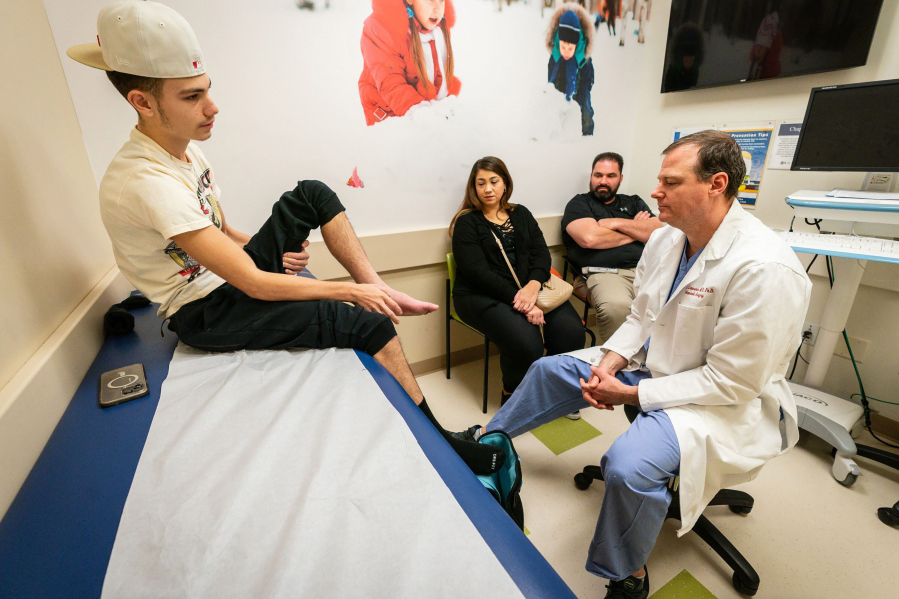PHILADELPHIA — Anthony Greco’s friends all got electric scooters last Christmas. So his parents surprised him with one later that winter.
Greco, 16, used his e-scooter to get to and from his summertime job at a plumbing company a few blocks from his family’s South Philadelphia home.
On a rainy August evening, he hit a pothole. The scooter fishtailed.
“I tried to hop off to save myself,” he recalled. “I immediately felt the snap of my foot.”
Greco broke his leg in two places. Injuries related to e-scooters are becoming increasingly common among teenage boys nationwide, according to new research by orthopedic experts at Children’s Hospital of Philadelphia. Some 8,500 people were injured using an e-scooter in 2021, a 71 percent increase from 5,012 such injuries in 2020, according to data culled from hospital emergency departments across the nation.
In recent years, e-scooters have become more popular as a mode of transportation, with newer models able to reach speeds over 50 mph.
“These electric scooters are the latest craze, and we’re seeing a lot of kids come in hurt by them,” said J. Todd Lawrence, a pediatric orthopedic surgeon at CHOP and senior author of the research study. “If you watch promo videos for e-scooters, they advertise that these things go really fast, like that’s the selling point.”
Lawrence said he treats accident-related, e-scooter injuries, mostly bone fractures, “at least once a week.” He began to notice an upward trend about four years ago, he said.
Lawrence, who has worked at CHOP for almost 14 years, said he’s seen a progression of injury-causing fads that hurt kids, everything from Heelys — sneakers with wheels — to Hoverboards, or self-balancing scooters on two motorized wheels.
“A lot of those things just kind of go away, like somebody figured out, ‘That was a stupid idea, like why do we want to make shoes that kids can slip on,’ “ Lawrence said.
But, he doesn’t see e-scooters — or the injuries they cause — going away, he said.
CHOP’s research, led by University of Pennsylvania medical student Radhika Gupta, analyzed data from the National Electronic Injury Surveillance System database, where emergency departments reported 13,557 injuries among patients under 18 from 2020 to 2021. Among the key findings:
- Most injuries occurred in spring and summer months.
- White teenage boys, ages 16 to 18, suffered the majority of injuries. (Researchers did not delve into possible reasons behind the racial gap.)
- The most common injury was fracture, and the most injured body part was the head, followed by the face.
- Of the patients asked about helmet use, only 32 percent reported wearing a helmet. Nearly 67 percent of those with head injuries weren’t wearing a helmet.
- Nearly 15 percent of accidents involved a motor vehicle, with either the rider hitting a car or vice versa.
- About 10 percent of the accidents involved hitting an obstacle, such as uneven ground — or pothole.
Greco hit the pothole on his way home from work at about 9:15 p.m. on Aug. 14. He found himself splayed on his back in the road. The force knocked one of his gray sneakers off. His left foot was grotesquely twisted. A bone jutted out from his skin, he said.
Lawrence took the teen into surgery the next day. He had suffered a compound fracture, breaking his tibia and fibula. Lawrence described Greco’s injury as “limb-threatening.” He was at risk of losing part of his leg from potential infection from debris in the wound.
“He had gravel grounded in his bone,” Lawrence recalled.
Greco’s mom, 36-year-old Krystine Greco, said she regretted buying him the e-scooter. He hadn’t asked for one, but she felt bad when his friends were out riding theirs and he was stuck at home waiting for them to finish.
Lawrence said he believes “micro-mobility” devices, like e-scooters, have positives. They help people get around fairly quickly and easily, and help reduce the number of cars on the road. Older teens who don’t yet drive can use them to get to school or work.
“I’m definitely stopping short of saying, ‘Don’t let your kid ride an e-scooter,’ but let’s use some of the data to say, ‘How can we help them be more safe?’ ” he said.
First off, a helmet. Don’t buy an e-scooter without one. And make sure your kid wears it.
Second, ride an e-scooter in places where cars don’t pose a danger. Lawrence said he’s a big fan of protected bike lanes.
Third, pick an e-scooter that’s appropriately powered and sized for a kid’s body. Follow all manufacturer directions, review safety information, and check weight and age limits for the device.
“Don’t pick one just because it goes the fastest,” Lawrence said. “Drive at a safe speed.”
Anthony Greco’s foot was in a cast from Aug. 16 to Oct. 6. He missed fun summer activities, like Shore trips. He goes to physical therapy three days a week.
“It’s a fun thing to ride, but there’s very scary outcomes that could happen from riding one,” he said. “I wanted people to be aware of what can happen.”



